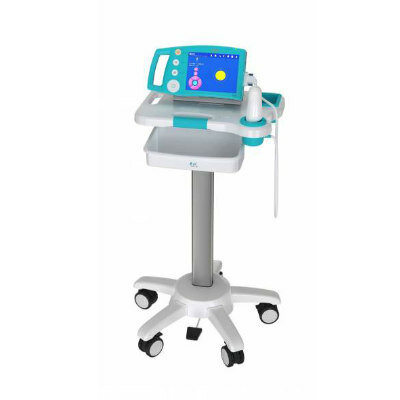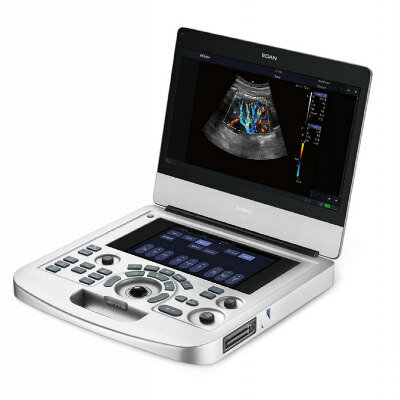Robotic Gamma Probe Detects Cancer Intra-Operatively 
|
By MedImaging International staff writers Posted on 27 Jan 2021 |

Image: The Sensei Robotic Gamma Probe (Photo courtesy of Lightpoint Medical)
A novel intra-operative probe detects sentinel lymph node (SLN) and other cancer metastases through the lymphatic system.
The Lightpoint Medical (Chesham, United Kingdom) Sensei is a tethered gamma probe designed to be used as a guide during laparoscopic biopsy procedures. The probe locates single-photon emission computed tomography (SPECT) radioligands, such as 99mTc-nanocolloid for SNL metastasis detection, or for targeted cancer metastasis antigens, such as 99mTc-PSMA (prostate specific membrane antigen) during prostate cancer surgery. The single-use, disposable probe measures just over 40mm and is attached to a three meter long lightweight cable, supporting both intra-cavity manual and robotic laparoscopic procedures.
When used with articulating graspers, the probe can provide up to six degrees of freedom, allowing for complete intra-cavity maneuverability and dexterity. The system provides clear audible notifications and is also equipped with a graphic display. It can also be integrated with the display of any surgical robotic platform. And as it is disposable, there is no need for a sterile sheath or reprocessing, eliminating the risk of cross-contamination. At the end of the procedure, the probe can be easily extracted through a standard 12mm entry port for disposal.
“Lightpoint is developing the most advanced intra-operative cancer detection technologies to meet surgeons' needs for miniaturized cancer detection tools,” said David Tuch, CEO of Lightpoint Medical. “Currently, surgeons have no way to precisely detect cancer intra-operatively. As a result, millions of patients suffer every year as cancer is frequently left behind or healthy, functional tissue is needlessly removed.”
Lymph nodes, located throughout the body, serve as biologic filters that contain immune cells to fight infection and clean the blood. When cancer cells break away from a tumor, the cells can travel through the lymph system, and SNLs help determine cancer spread. But human SNLs are only half a centimeter in size, and are difficult to discern among the surrounding tissue during surgery. Furthermore, even when surgeons are able to map the location of the nodes, there is no current technique that indicates whether or not the lymph nodes contain cancer, requiring their removal.
Related Links:
Lightpoint Medical
The Lightpoint Medical (Chesham, United Kingdom) Sensei is a tethered gamma probe designed to be used as a guide during laparoscopic biopsy procedures. The probe locates single-photon emission computed tomography (SPECT) radioligands, such as 99mTc-nanocolloid for SNL metastasis detection, or for targeted cancer metastasis antigens, such as 99mTc-PSMA (prostate specific membrane antigen) during prostate cancer surgery. The single-use, disposable probe measures just over 40mm and is attached to a three meter long lightweight cable, supporting both intra-cavity manual and robotic laparoscopic procedures.
When used with articulating graspers, the probe can provide up to six degrees of freedom, allowing for complete intra-cavity maneuverability and dexterity. The system provides clear audible notifications and is also equipped with a graphic display. It can also be integrated with the display of any surgical robotic platform. And as it is disposable, there is no need for a sterile sheath or reprocessing, eliminating the risk of cross-contamination. At the end of the procedure, the probe can be easily extracted through a standard 12mm entry port for disposal.
“Lightpoint is developing the most advanced intra-operative cancer detection technologies to meet surgeons' needs for miniaturized cancer detection tools,” said David Tuch, CEO of Lightpoint Medical. “Currently, surgeons have no way to precisely detect cancer intra-operatively. As a result, millions of patients suffer every year as cancer is frequently left behind or healthy, functional tissue is needlessly removed.”
Lymph nodes, located throughout the body, serve as biologic filters that contain immune cells to fight infection and clean the blood. When cancer cells break away from a tumor, the cells can travel through the lymph system, and SNLs help determine cancer spread. But human SNLs are only half a centimeter in size, and are difficult to discern among the surrounding tissue during surgery. Furthermore, even when surgeons are able to map the location of the nodes, there is no current technique that indicates whether or not the lymph nodes contain cancer, requiring their removal.
Related Links:
Lightpoint Medical
Latest Nuclear Medicine News
- New SPECT/CT Technique Could Change Imaging Practices and Increase Patient Access
- New Radiotheranostic System Detects and Treats Ovarian Cancer Noninvasively
- AI System Automatically and Reliably Detects Cardiac Amyloidosis Using Scintigraphy Imaging
- Early 30-Minute Dynamic FDG-PET Acquisition Could Halve Lung Scan Times
- New Method for Triggering and Imaging Seizures to Help Guide Epilepsy Surgery
- Radioguided Surgery Accurately Detects and Removes Metastatic Lymph Nodes in Prostate Cancer Patients
- New PET Tracer Detects Inflammatory Arthritis Before Symptoms Appear
- Novel PET Tracer Enhances Lesion Detection in Medullary Thyroid Cancer
- Targeted Therapy Delivers Radiation Directly To Cells in Hard-To-Treat Cancers
- New PET Tracer Noninvasively Identifies Cancer Gene Mutation for More Precise Diagnosis
- Algorithm Predicts Prostate Cancer Recurrence in Patients Treated by Radiation Therapy
- Novel PET Imaging Tracer Noninvasively Identifies Cancer Gene Mutation for More Precise Diagnosis
- Ultrafast Laser Technology to Improve Cancer Treatment
- Low-Dose Radiation Therapy Demonstrates Potential for Treatment of Heart Failure
- New PET Radiotracer Aids Early, Noninvasive Detection of Inflammatory Bowel Disease
- Combining Amino Acid PET and MRI Imaging to Help Treat Aggressive Brain Tumors
Channels
Radiography
view channel
Novel Breast Imaging System Proves As Effective As Mammography
Breast cancer remains the most frequently diagnosed cancer among women. It is projected that one in eight women will be diagnosed with breast cancer during her lifetime, and one in 42 women who turn 50... Read more
AI Assistance Improves Breast-Cancer Screening by Reducing False Positives
Radiologists typically detect one case of cancer for every 200 mammograms reviewed. However, these evaluations often result in false positives, leading to unnecessary patient recalls for additional testing,... Read moreMRI
view channel
PET/MRI Improves Diagnostic Accuracy for Prostate Cancer Patients
The Prostate Imaging Reporting and Data System (PI-RADS) is a five-point scale to assess potential prostate cancer in MR images. PI-RADS category 3 which offers an unclear suggestion of clinically significant... Read more
Next Generation MR-Guided Focused Ultrasound Ushers In Future of Incisionless Neurosurgery
Essential tremor, often called familial, idiopathic, or benign tremor, leads to uncontrollable shaking that significantly affects a person’s life. When traditional medications do not alleviate symptoms,... Read more
Two-Part MRI Scan Detects Prostate Cancer More Quickly without Compromising Diagnostic Quality
Prostate cancer ranks as the most prevalent cancer among men. Over the last decade, the introduction of MRI scans has significantly transformed the diagnosis process, marking the most substantial advancement... Read moreUltrasound
view channel
Deep Learning Advances Super-Resolution Ultrasound Imaging
Ultrasound localization microscopy (ULM) is an advanced imaging technique that offers high-resolution visualization of microvascular structures. It employs microbubbles, FDA-approved contrast agents, injected... Read more
Novel Ultrasound-Launched Targeted Nanoparticle Eliminates Biofilm and Bacterial Infection
Biofilms, formed by bacteria aggregating into dense communities for protection against harsh environmental conditions, are a significant contributor to various infectious diseases. Biofilms frequently... Read moreNuclear Medicine
view channel
New SPECT/CT Technique Could Change Imaging Practices and Increase Patient Access
The development of lead-212 (212Pb)-PSMA–based targeted alpha therapy (TAT) is garnering significant interest in treating patients with metastatic castration-resistant prostate cancer. The imaging of 212Pb,... Read moreNew Radiotheranostic System Detects and Treats Ovarian Cancer Noninvasively
Ovarian cancer is the most lethal gynecological cancer, with less than a 30% five-year survival rate for those diagnosed in late stages. Despite surgery and platinum-based chemotherapy being the standard... Read more
AI System Automatically and Reliably Detects Cardiac Amyloidosis Using Scintigraphy Imaging
Cardiac amyloidosis, a condition characterized by the buildup of abnormal protein deposits (amyloids) in the heart muscle, severely affects heart function and can lead to heart failure or death without... Read moreGeneral/Advanced Imaging
view channel
New AI Method Captures Uncertainty in Medical Images
In the field of biomedicine, segmentation is the process of annotating pixels from an important structure in medical images, such as organs or cells. Artificial Intelligence (AI) models are utilized to... Read more.jpg)
CT Coronary Angiography Reduces Need for Invasive Tests to Diagnose Coronary Artery Disease
Coronary artery disease (CAD), one of the leading causes of death worldwide, involves the narrowing of coronary arteries due to atherosclerosis, resulting in insufficient blood flow to the heart muscle.... Read more
Novel Blood Test Could Reduce Need for PET Imaging of Patients with Alzheimer’s
Alzheimer's disease (AD), a condition marked by cognitive decline and the presence of beta-amyloid (Aβ) plaques and neurofibrillary tangles in the brain, poses diagnostic challenges. Amyloid positron emission... Read more.jpg)
CT-Based Deep Learning Algorithm Accurately Differentiates Benign From Malignant Vertebral Fractures
The rise in the aging population is expected to result in a corresponding increase in the prevalence of vertebral fractures which can cause back pain or neurologic compromise, leading to impaired function... Read moreImaging IT
view channel
New Google Cloud Medical Imaging Suite Makes Imaging Healthcare Data More Accessible
Medical imaging is a critical tool used to diagnose patients, and there are billions of medical images scanned globally each year. Imaging data accounts for about 90% of all healthcare data1 and, until... Read more
Global AI in Medical Diagnostics Market to Be Driven by Demand for Image Recognition in Radiology
The global artificial intelligence (AI) in medical diagnostics market is expanding with early disease detection being one of its key applications and image recognition becoming a compelling consumer proposition... Read moreIndustry News
view channel
Bayer and Google Partner on New AI Product for Radiologists
Medical imaging data comprises around 90% of all healthcare data, and it is a highly complex and rich clinical data modality and serves as a vital tool for diagnosing patients. Each year, billions of medical... Read more





















